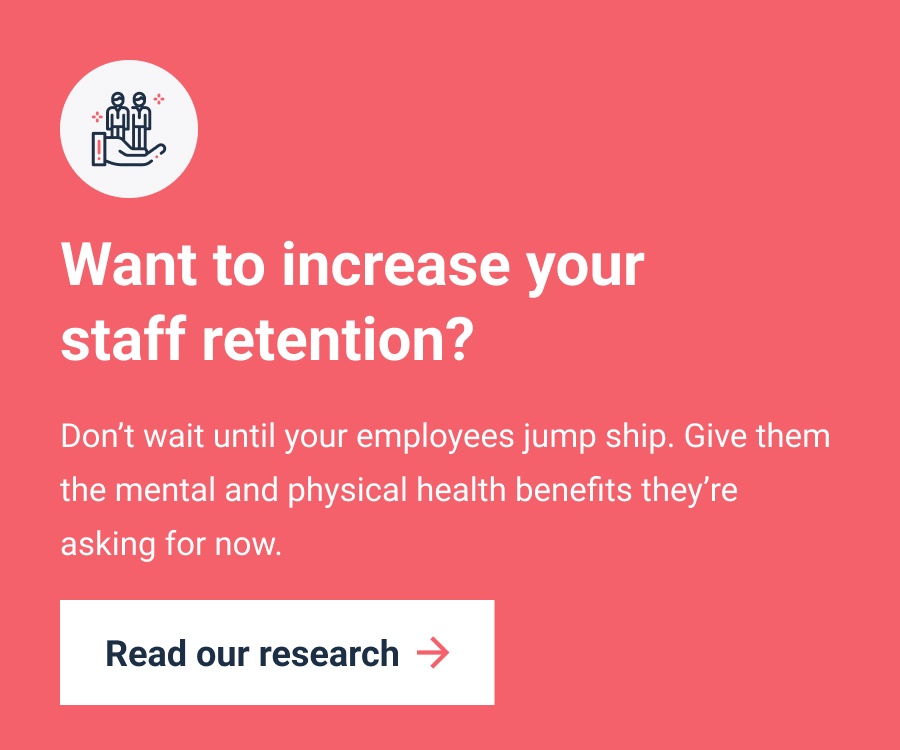Did you know that only half of organisations take a strategic approach to employee wellbeing? And, according to the research, those companies that do are far more likely to report positive achievements from their activity. That’s at both the individual and organisational level.
Chances are, you already conduct employee engagement or wellbeing surveys each year. But these surveys will only help you increase engagement and wellbeing if you measure the right metrics. As management theorist Peter Drucker once said ‘What gets measured gets improved.’
So, what should you be measuring? Well, here are six metrics that your HR team should be keeping track of.
Measurements of success: 6 metrics for HR teams
1. Awareness of your wellbeing initiatives
Do your employees know what wellbeing benefits are available to them? If they don’t, they won’t be able to make use of them to improve their mental and physical health. This metric will show you how well you’ve communicated your wellbeing package across your organisation.
You can gauge awareness levels in your company through anonymous questionnaires and focus groups. Ask your employees directly how much they know about the health benefits offered to them. You can send questionnaires and discussion invites out via email, or set something up in a wellbeing-dedicated Slack channel.
Once you know how many of your employees are aware of wellbeing support, you can start to dig deeper.
2. Utilisation of your wellness programmes, apps or benefits
Based on our own research, 21 percent of employees say they never use the health-related benefits offered by their employer?
If you include multiple tools and resources in your wellbeing package, enlist the help of your team leaders and take regular polls. Sending out surveys to your employees can help track how their usage habits change over time, and how satisfied your employees with the content they receive.
A digital wellbeing app like Symbio streamlines this entire process for you. The Symbio Hub allows you to find out what’s working with detailed insights into your employees’ usage and wellbeing progress. You can also segment wellbeing insights based on factors like team and location to understand the specific wellness needs of every part of your business.
3. Employee turnover rates
Still in the throes of the Great Resignation, employee turnover rates remain extremely high. Your HR teams should constantly monitor employee turnover as it can be a definite indicator of employee dissatisfaction.
You can calculate employee turnover with some simple maths. Divide the number of employees who left your company by the average number of employees at a certain time point. You then multiply that number by 100 to give you a percentage.
If you want to go into more detail, perhaps look into voluntary vs involuntary turnover. This will help you understand the reasons behind staff leaving, and whether employees left due to dissatisfaction or termination.
4. Number and frequency of employee absences
Employee absences are slowly increasing, rising to 2.2 percent in 2021. This steady rise in absenteeism is important to keep track of, as it can cost businesses huge amounts of money.
Absences are going to happen. Employees need time off for sickness, holiday, bereavement, maternity leave…the list goes on. What’s important is tracking absences in comparison to national averages, and averages for your industry. This will help you understand if your rates are abnormal.
You probably have a HR information system (HRIS) in place to track absences as they happen. To explore the data further though, try breaking it down by individual, or by team. This will give more insight into how absence rates differ across your organisation.
5. Symptom frequency and severity
During those absences, what symptoms did your employees report? Were they mainly physical or mental issues? What does that say about the impact of your wellness programmes?
This information will help you tailor your wellbeing resources to the needs of your staff. If certain individuals are more prone to mental health issues, you can adapt your resources to account for this, and similarly for physical health issues. Indeed, while carrying out our own research we found that 28 percent of employees said they valued a personalised approach when it came to wellbeing support.
The severity of the issues will also inform the level of support you provide. For example, if employees are dealing with complex health issues, you may choose to provide access to certified medical professionals who can provide a higher level of care. Or perhaps, look into your return to work policies to see how you can support those with complex conditions to continue working in a way that’s right for them.
6. Employee satisfaction rates and stress levels
This is the big one. Sadly, a third of workers report being unhappy with their jobs. Not only that, but three in four employees find that workplace unhappiness impacts their mental or physical health.
Employee satisfaction is important to measure because it has a knock-on effect on other aspects of your organisation. For example, there’s a strong link between high employee satisfaction and:
- A lower turnover
- Increased productivity
- Positive company culture
You can measure employee satisfaction in a few ways, including:
- Conducting employee engagement surveys
- Having regular one to ones with managers
- Collecting feedback in a suggestion box
What to do with these metrics
Once you’ve gathered your metrics, compare the employees’ experiences to your intended predictions and outcome.
Then, ask yourself the right questions. If you designed your employee wellness programmes to lower stress, did you achieve that? If stress levels are high, what’s the reason for this? If, for example, uptake of your wellbeing app is high but employees are still feeling stressed, it may be a sign you need to work with line managers to ensure company policies are being rolled out consistently to complement the support you’re offering.
These metrics will help you make informed improvements. They’ll help you manage employee wellbeing more objectively and drive the direction of your organisation.
And, if you’re looking to streamline your wellbeing package to make tracking these metrics easier, try using a digital wellbeing app like Symbio. Book a demo today to get started.






